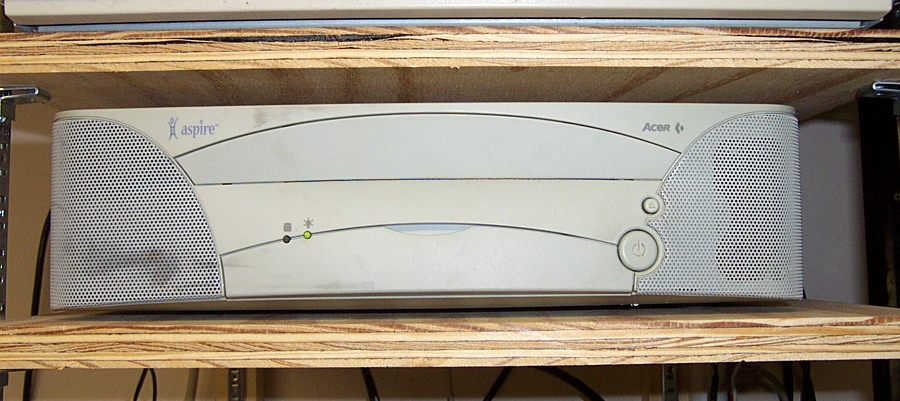A lack of opportunity pitted against tenacious curosity
2019 Jun 06 - Brian Kloppenborg
Introduction
While doing some spring cleaning, I found a hard drive which contained backups of all of my websites from the early 2000s and a few photos of the equipment which I used to host said sites. Seeing these things inspired me to resurrect some of this content (see tag: old-content). In doing so, I realized that learning how to code and host my own services at such a young age forged a career path that was unlikely for youth in rural Nebraska.
A lack of opportunity
In the late 1990s and early 2000s, rural Nebraska provided few opportunities for tech savvy youth to garner high-tech skills. My high school had a few vocational courses which catered to local industry, but nothing resembling software development. There simply wasn’t a need: the largest employers in the region were in the fields of health care, education, and manufacturing. There was also a considerable number of agricultural companies and the usual smattering of retail shops. Although all of these companies used software, few were looking for folks that could code. In fact, when I was looking for my first full-time job the only advertised software development gig was 60 miles away! This situation has changed somewhat in the last 20 years: my high school offers a “Web Page Design & Development” course (which teaches HTML, CSS, and JavaScript) and there are a few companies which have entry-level software development positions advertised online.
Unfortunately, the lack of high-tech jobs in my home town in the 2000s meant that most of the youth settled for low-tech jobs.A typical career would start in agriculture, working for farmers, around the age of 14. Typically, this would be detasseling corn. Once you reached 16, you would get a job in retail, waiting tables at restaurants, or working in the manufacturing sector. For example, I went from detasseling to working in a lumber store stocking shelves. My wife worked in fast food. One of my peers made a ton of money welding for a local manufacturer.
Tenacious curiosity
Although my career started along a similar trajectory to my peers, there is one important distinction: I’m exceptionally curious about technology. In high school I learned how to program the TI-83 and build web pages. My first website was MaxisVille, a website dedicated to SimCity 2000, SimCopter, and Streets of SimCity. The site started out on GeoCities in 1998, moved to VirtualAve.net in late 1999 as they provided Server Side Includes for free. In 2000 I moved the website to HyperMart.net and then SimStuff.com as free hosting providers were becoming less capable. In 2004, I moved all of my websites to a server (pictured and described below) I hosted at home on a 128 kbps down / 64 kbps up connection. Doing so let me develop the following skills:
- Perl scripting to search Apache logs for missing pages and generate rudimentary page view information.
- PHP and MySQL to make dynamic web pages.
- Installation, configuration, and maintenance of software on Linux.
- The ability to inspect my code for security vulnerabilities (suffice it to say, I found some).
Later I would go on to use this server to make money. I built an entire content management system for Hastings Head Start in 2006, created a web-enabled vehicle maintenance tracking system in 2009, constructed a web application to visualize and sell window cornices for Designers Index, and installed a modern Content Management System for the Nebraska Head Start Association in 2010. After moving away in 2012, administration of most of these websites were taken over by local businesses.
Conclusion
Since then, I’ve continued to use my technological skills to do awesome things. Most recently, my image reconstruction software from 2010 was cited in the M87 black hole image paper in Nature. Now, I wouldn’t claim anything I’ve done to be as amazing as the 16-year old who earned $200k by developing a Twitter App or most of the other success stories by young individuals posted on on HackerNews; however it wasn’t bad start for a kid from rural Nebraska.
Epilogue: In memory of my first webserver
My first webserver was a used, six-year-old Acer Aspire 2190m desktop I received from a neighbor in exchange for removing malware from their new computer. As you can see from the specifications below, the machine was quite modest: it ran RedHat Linux 9.0 on a 333 MHz processor with 196 MB of RAM and a 4.3 GB hard drive. My Internet connection was similarly modest: 128 kbps down / 64 kbps up. Despite its low power, it was still a great machine for learning and experimenting.
| Processor | AMD K6®-2 333MHZ Processor |
| Cache | 512K |
| Memory | 196 MB Expandable to 256 MB |
| Video | ATI 3D Rage IIC graphics accelerator 4MB video memory |
| Storage | 4.3GB IDE Hard Drive One 3.5" 1.44MB diskette 32x maximum CD-ROM drive Aspire Desktop HSF-SP |
| Modem | 56Kbps modem (V.90 ITU and K56Flex standards) |
| Ethernet | 10/100 PCI Adapter (added) |
| Ports | 4 USB ports (2 open), Parallel printer port |
| Operating System | RedHat Linux 9.0 with Linux Kernel 2.4.20 |
| Software | httpd (Apache) 2.0.40 PHP 4.2.2 MySQL 3.23.54 |
